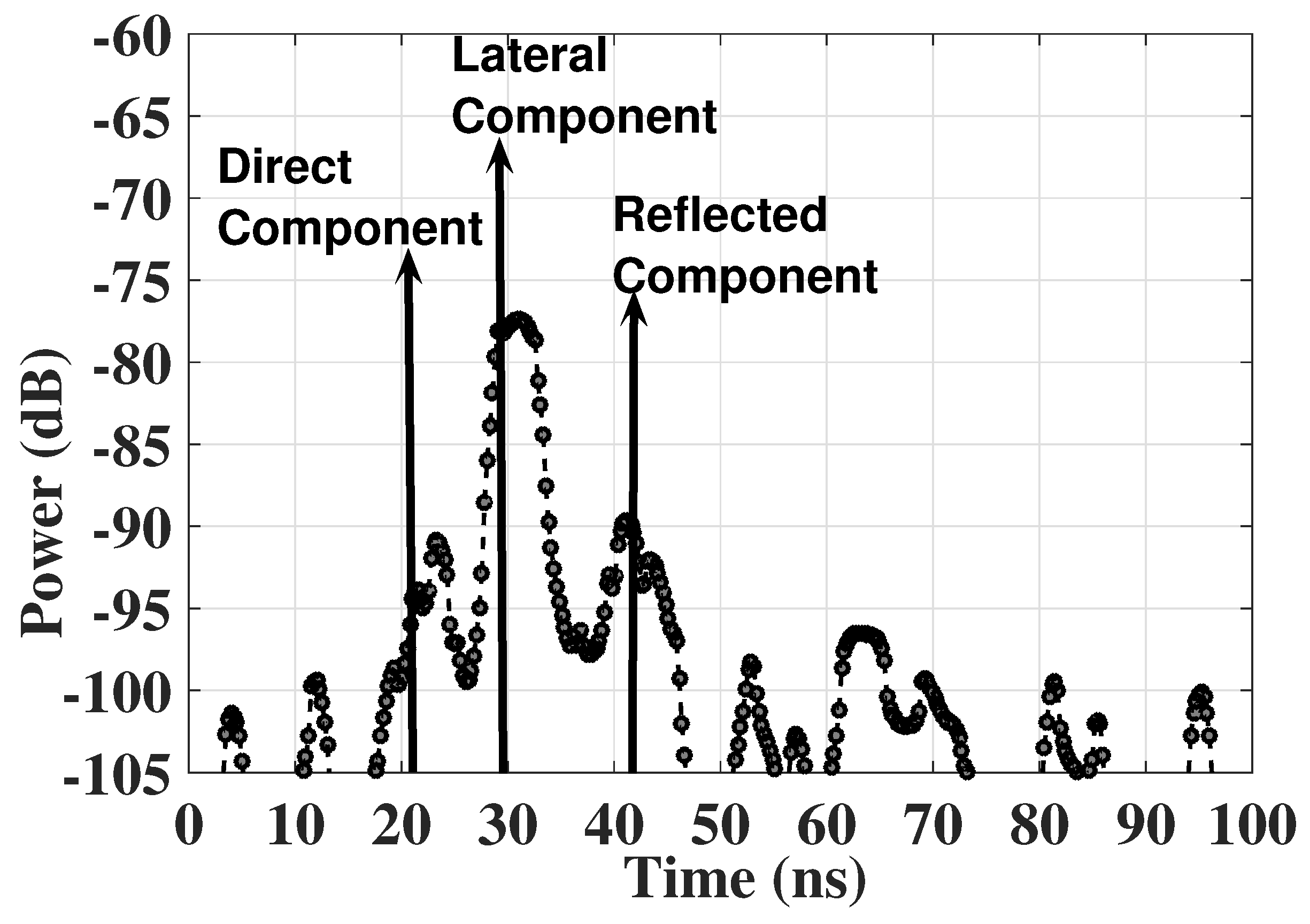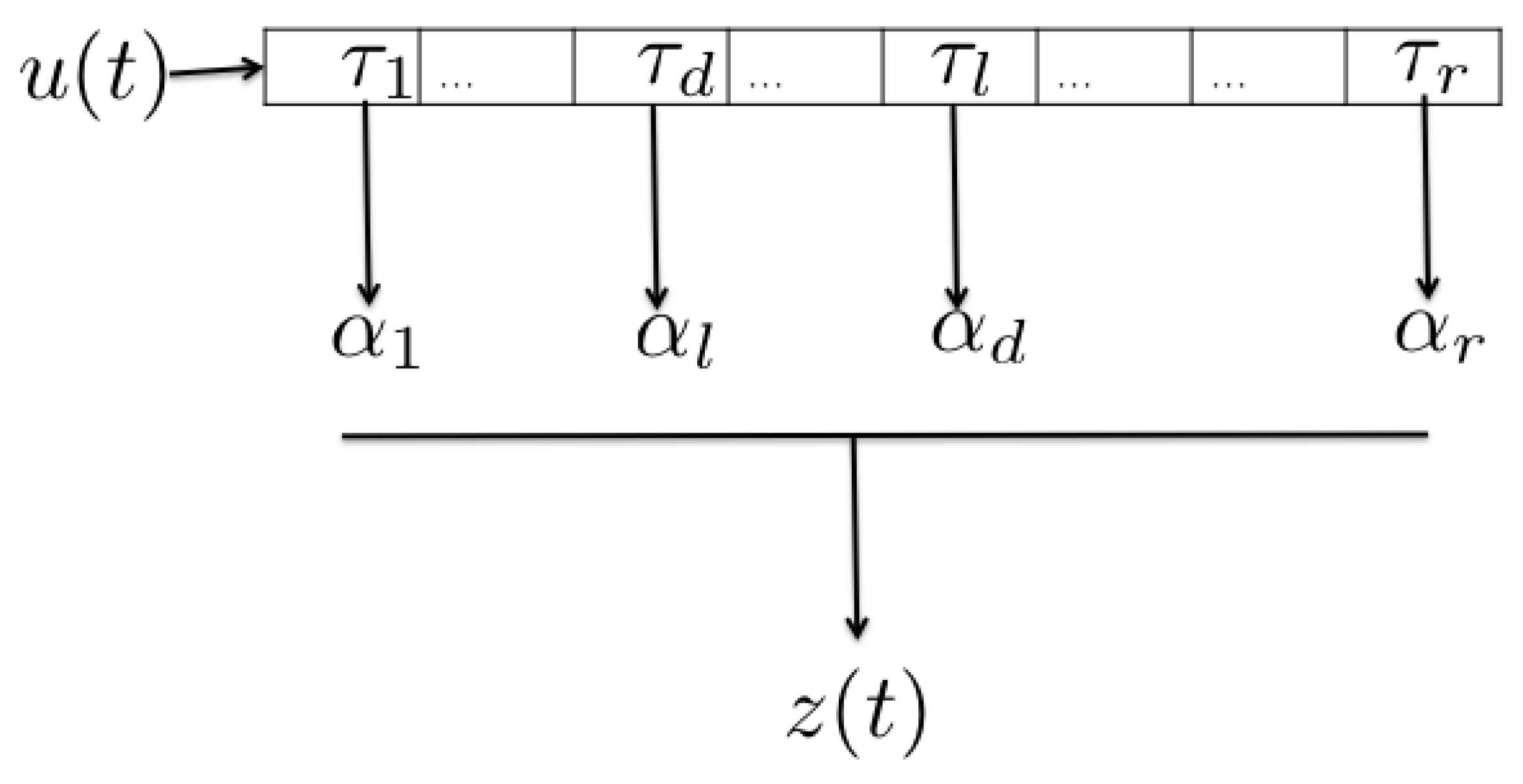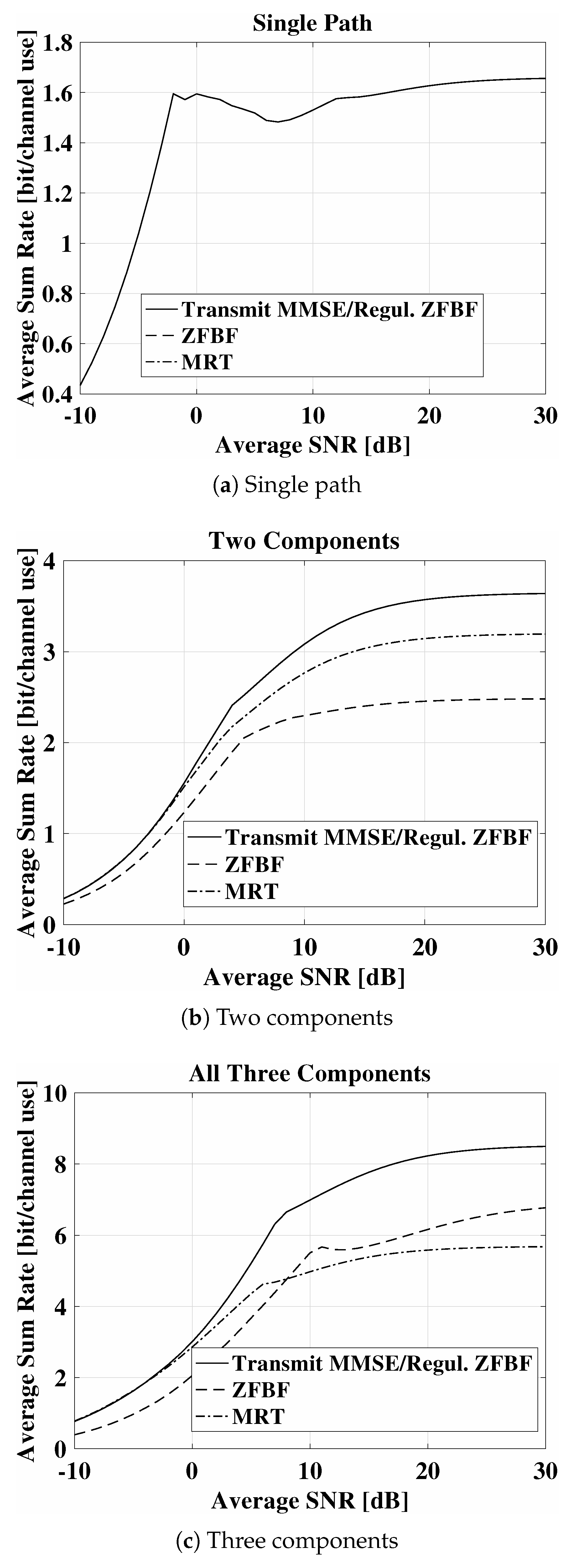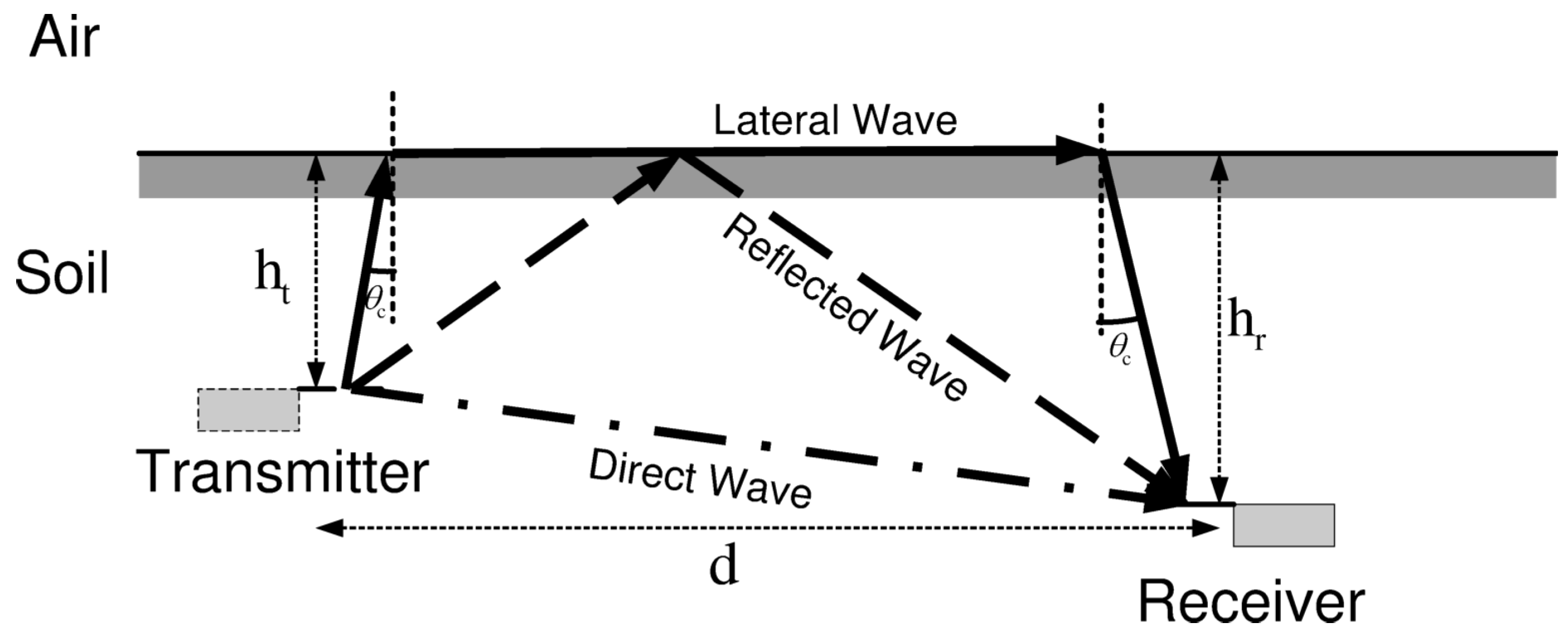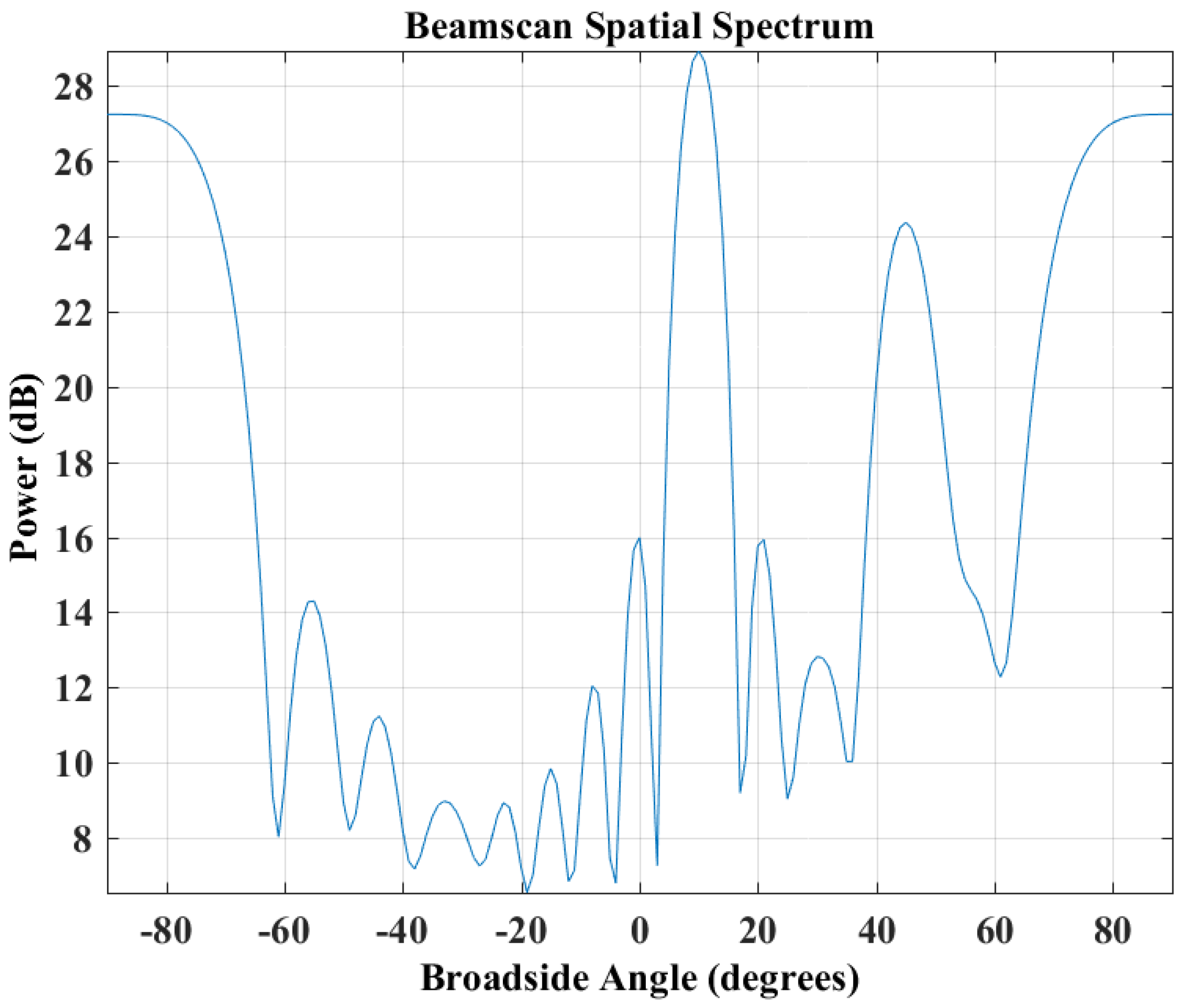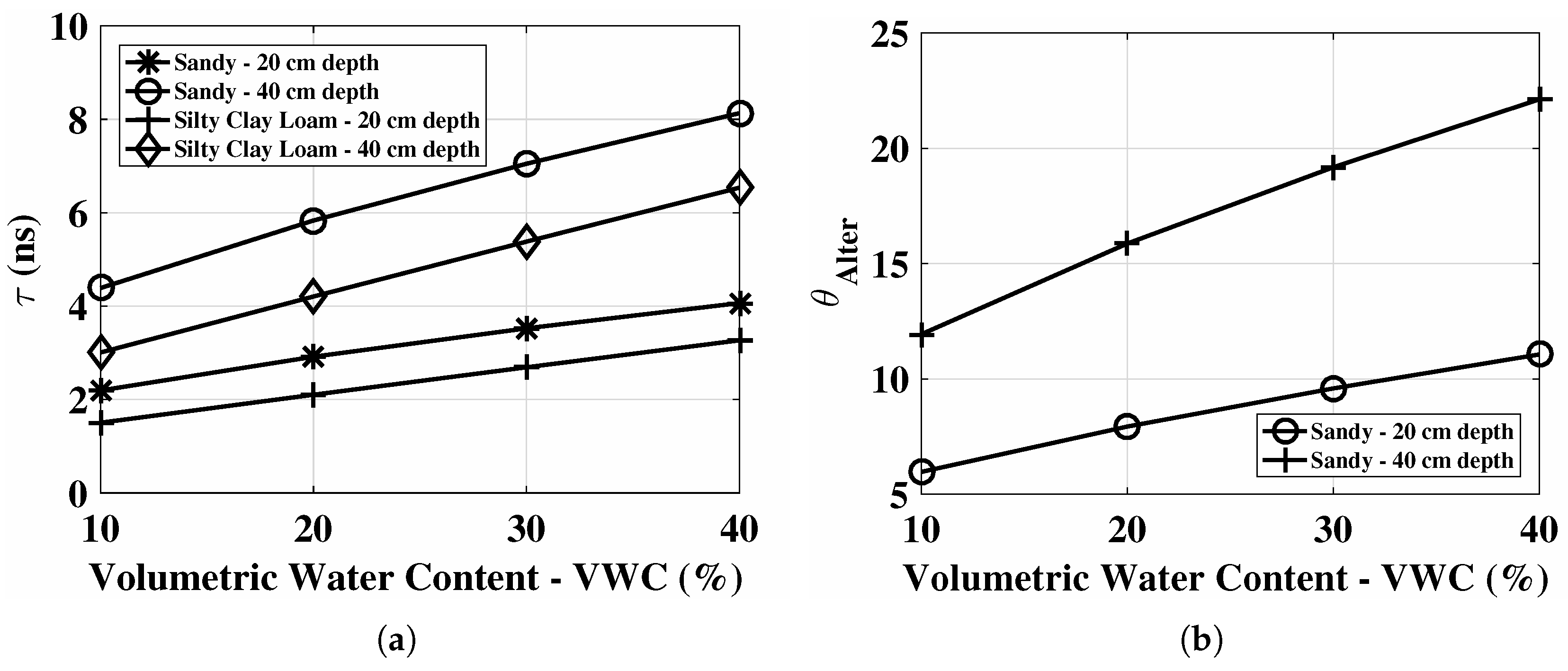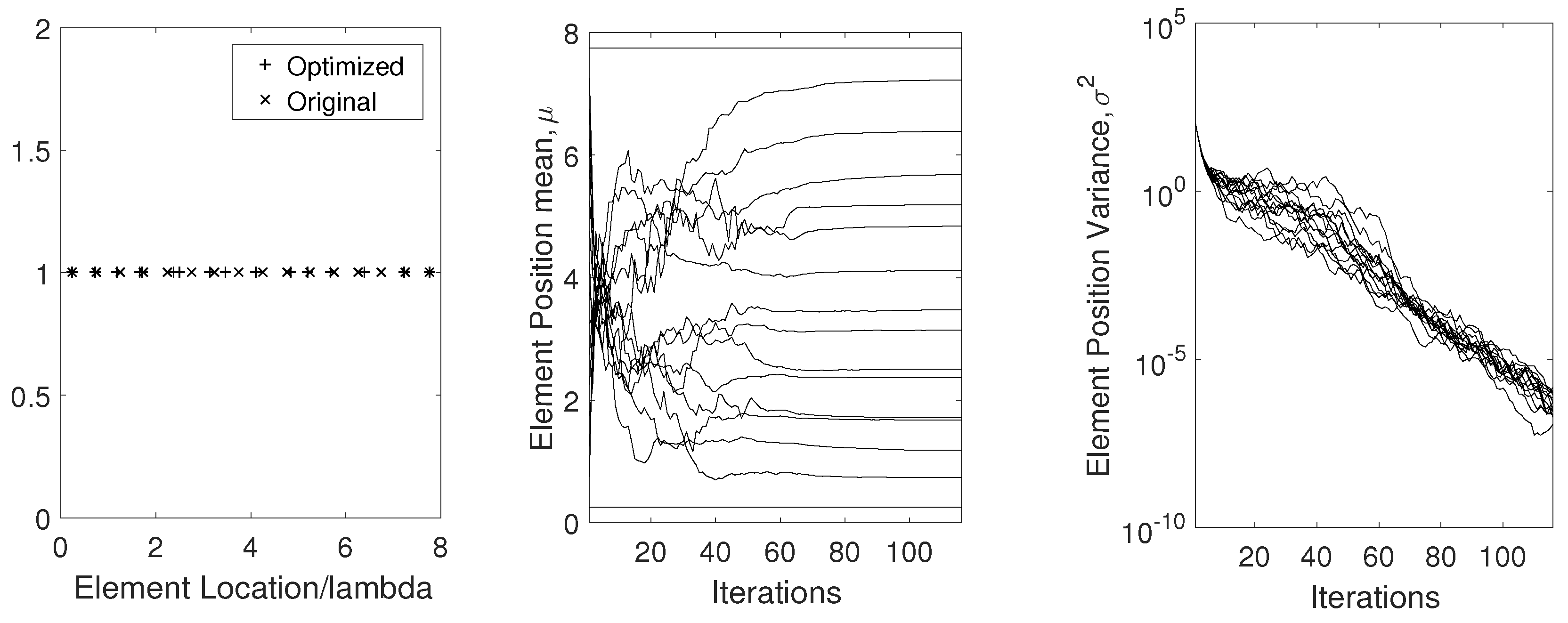1. Introduction
The purpose of digital agriculture is to tailor agricultural inputs and processes to localized environments in the farm to apply correct practices in the field in a timely and correct manner. It leads to the development of smart and digital sensing, communications, and real-time decision-making systems to sense, analyze, detect, and manage the soil and farm-specific spatial and temporal patterns in the field for sustainability, profitability, and to protect the environment.
The Internet of Underground Things (IOUT) have many applications in precision agriculture [
1,
2,
3,
4,
5,
6,
7,
8,
9,
10,
11,
12]. Border monitoring is another important application area of IOUT, where these networks are being used to enforce borders and stop infiltration [
13,
14]. Monitoring applications of IOUT include landslide monitoring and pipeline monitoring [
5,
15,
16]. IOUT provides seamless access to information collected from agricultural fields through the Internet. IOUT includes in situ soil-sensing capabilities (e.g., soil moisture, temperature, salinity), and provides the ability to communicate through plants, soil and real-time information about the environment (e.g., wind, rain, solar). When interconnected with existing machinery on the field (seeders, irrigation systems, combines), IOUT enables complete autonomy in the field, and paves the way for more efficient food production solutions. At agricultural farm level, IOUT is being used to provide valuable information to farmers.
By using software-defined control of individual antenna elements, steering solutions for communications with static and mobile aboveground devices in digital agriculture can be implemented [
17,
18]. This kind of implementation of underground (UG) beamforming is challenging for many reasons. The major challenge is the phase shift between antenna elements. To get a desired beam pattern, the phase shifts between antenna elements need to be equal in the desired direction. This requires calibration of phase shifters and dynamic on-the-fly phase correction to achieve the desired beam. To address these challenges, digital beamforming using phased-array antennas based on soil moisture conditions to form dynamic beam patterns can be employed. We have investigated three different array designs. First design consists of two separate linear arrays, each with its own phase shifter with pre-defined parameters for communication with underground and aboveground arrays. Furthermore, beams are stitched such that several beam patterns are determined and designed based on the analyses of underground and aboveground devices and stored in a configuration database for on-demand use. The second design is based on two arrays stacked at different UG depths with phase shifting done in the software. This approach is based on processing in the software-defined radio to adapt to wavelength changes due to soil moisture conditions. The advantage of using this approach is that dynamic changes in the wavelength and phase variations due to UG channel dynamism can be compensated for without changing physical array arrangements. Moreover, less energy is required in comparison to traditional mechanical phase shifters. In the third design, the multi-dimensional arrays, structured in rectangular, planar, and circular arrangements to have simultaneous beams in multiple planes, are used.
UG transmit beamforming using phased-array antennas at the transmitter [
18] has been used in the UG communications to maximize the lateral wave [
19] by transmitting energy at a particular angle. By using this approach, the energy waste by sending signals in isotropic direction is reduced by forming the narrow-width beam and steering it accordingly. In underground wireless communications, the aim is to enhance the received signal strength and reduce the interference at the receiver. In over-the-air (OTA) wireless communications, a strong signal strength is attained by transmitting the signal from multiple antennas at different amplitudes and phases. Through this approach, the received signal components add coherently at the receiver. However, in underground communication, due to different wave propagation speed in different communication mediums (e.g., soil and air), coherent combining at the receiver in a constructive manner cannot be achieved. Therefore, an environment-aware UG multiple-input and multiple-output (MIMO) design is required.
The line-of-sight (LoS) component between the UG transmitter and receiver has limitations because of the higher attenuation in the soil medium. An example power delay profile (PDP) of wireless UG channel is shown in
Figure 1. Moreover, the direct path has shorter range and cannot be used to reach longer distances in the underground medium. Therefore, combined transmit and receive beamforming needs to be developed using non-LoS components (e.g., lateral and reflected). Since multipath underground channels are well-known [
19] and have been studied and empirically validated, UG MIMO can be developed for high-data-rate and long-range communications. In this work, techniques have been developed to maximize the signal strength and minimize the interference at the receiver. Moreover, UG MIMO beamforming expressions have been developed to maximize the capacity of underground communications.
The rest of the paper is organized as follows: the background and major contributions of this work are discussed in
Section 3. The UG MIMO is modeled in
Section 4. Performance evaluations are done in
Section 5. The article concludes in
Section 8.
2. Related Work
An empirical analysis using off-the-shelf sensor motes to characterize the path loss in the UG channel was conducted in [
19], and accordingly, path-loss models for underground-to-underground (UG2UG) and underground-to-aboveground (UG2AG) channels have been developed in [
9].
Moreover, digital agriculture solutions including enabling technologies for subsurface antenna design [
8], underground cognitive radio [
20], and soil moisture sensing using subsurface radio-wave propagation have been developed for IOUT [
11,
12]. Accordingly, we devised a subsurface planar antenna [
8], which combats adverse effects of time-variant subsurface radio channel characteristics and extends communication ranges of underground radios. This allows for development of architectures for connected soil moisture-sensing networks and automated irrigation solutions [
11,
12]. Moreover, it is shown that software-defined operation in underground communications can extend the capacity of the UG channel. The development of IoT-based smart security and monitoring devices for agriculture was investigated in [
21]. A survey on advances in magnetic induction-based wireless underground sensor networks was presented in [
22]. A secure smart agriculture monitoring technique through isolation was developed in [
23]. The IoT vision, key features, applications, and open issues were discussed in [
24]. IoT in agriculture, its recent advances, and future challenges were outlined in [
25].
Beamforming antennas [
26] are being used in wireless networks to reduce interference and improve capacity. Beamforming has been addressed in [
27,
28,
29,
30,
31,
32,
33,
34,
35] for OTA wireless channels and in [
36] for MI power transfer, but no existing work has considered underground beamforming. In UG communications, lateral component [
37] has the potential, via beamforming techniques, to reach farther UG distances, which otherwise are limited (10
to 15
) because of higher attenuation in soil [
19].
3. Contributions of This Work
This is the first work to design a fully UG MIMO for UG communications. Transmit and receive beamforming techniques are considered, which communicate through the soil by using the UG channel medium. Based on the receiver position, EM waves either travel completely through the soil for UG communications or some part of it goes through the air for aboveground (AG) communications.
We leverage a UG channel impulse response model for the UG beamforming perspective and identify the major EM wave components. Challenges in UG beamforming are highlighted, and use of UG MIMO is motivated. We present the effects of different soil properties on beamforming vectors of the transmitter and receiver. This proposed mechanism estimates the best beam-steering angle based on the soil moisture sensing.
We have considered an UG MIMO transceiver system where both transmitter and receiver the beamforming capability. Additionally, this approach removes the intercomponent interference and enhances the received signal strength. Underground environment-aware MIMO using transmit and receive beamforming is vital for increased spectral efficiency, enhanced communication range, and energy efficiency in next-generation wireless underground networks, which are expected to include underground antenna arrays [
18]. The UG MIMO approach has potential applications in many practical scenarios such as precision agriculture, ground-penetrating radars (GPR), hazardous object search, locating IEDs, transmission structures under runways for aircraft communications, antennas for geographic research, communications from marshes, geology, and wireless underground sensor networks (WUSNs).
4. The UG MIMO System Models
Underground nodes communicate with other underground nodes (UG2UG link) and aboveground nodes (UG2AG link). A communications schematic for UG MIMO communications is shown in
Figure 2. These aboveground nodes are fixed sinks and mobile nodes are mounted on movable infrastructures such as center pivot. In aboveground communications, waves propagating to receiver nodes are refracted from the soil–air interface, whereas in UG communications, lateral waves need to be used. Desired beam patterns for both scenarios are shown in
Figure 2. In
Figure 2a, refractions and reflections of EM waves from the soil–air interface affect the beam patterns propagating to the aboveground node.
In UG MIMO, transmit beamforming [
18] is used to focus energy in the desired direction. There are three different paths [
19] in the underground soil medium through which the waves propagates to reach the receiver. When the UG receiver receives a desired data stream only from the desired path, then the UG MIMO channel becomes a three-path (lateral, direct, and reflected) interference channel. Accordingly, the capacity region of the UG MIMO three-path interference channel and degrees of freedom (multiplexing gain of this MIMO channel) requires careful modeling. Therefore, expressions are required to derive the degrees of freedom of the UG MIMO interference channel.
The underground receiver needs to perfectly cancel the interference from the three different components of the EM waves propagating in the soil medium. In UG transmit beamforming, limited numbers of antennas can only achieve low spatial directivity, which leads to the presence of signals in undesired directions causing interference at the receiver. This UG MIMO concept is based upon reducing the interference of the undesired components to a minimum at the UG receiver using the receive beamforming. In this paper, underground environment-aware MIMO using transmit and receive beamforming has been developed. The optimal transmit and receive beamforming combining vectors under minimal intercomponent interference constraints are derived. Accordingly, UG MIMO techniques are designed and investigated in the underground soil medium. Next we present the system model.
We consider a UG MIMO transceiver system where both transmitter and receiver has beamforming capability. We also consider that the transmitter node is equipped with two or more transmit antennas and has beam-steering capacity. The receiver node is also equipped with multiple antennas and can receive all three components propagating through the underground medium. In this paper, we also assume that the UG MIMO receiver has path selection and switching capability through a selection mechanism, which is based on the strength of the received paths at the receiver. Throughout the development of this approach, we also assume equal power allocation at the UG MIMO transmitter. To analyze the achievable capacity using environment-aware MIMO using transmit and receive beamforming, we also assume a total power constraint.
Next, we present a zero-forcing (ZF) UG MIMO transceiver technique. This approach does not require the availability of the channel state at the receiver in contrast to the OTA MIMO techniques. Additionally, this approach removes the intercomponent interference and enhances the received signal strength. The channel between the underground transmitter T and underground receiver R is represented by
of size
×
with complex values, where
and
represents the number of transmit and receive antennas, respectively. The
k spatial underground components are distinguished using the
, … ,
where w is associated with component. A
×
matrix
denotes the interference between different components. The received signal at the underground receiver by using equal power constraint is given by [
38]:
where
is the transmitted signal of the UG component
k, and
and
are the transmit and receive beamforming vectors,
is additive white Gaussian noise (AWGN) vector.
Next, we present the expression to maximize the capacity for the low SNR case. From the (
1), the received SINR at the UG receiver at the
kth component can be expressed as:
The achievable capacity for the three underground EM components is defined as:
Since the objective of this approach is to enhance the channel gain and to remove the intercomponent interference, we have only considered the beamforming vectors under the lower bound of achievable capacity. Therefore, maximum rate is not achieved because only the product achievable rate is used. Next we present the approach to completely remove the intercomponent interference. The instantaneous SNR for every sensed component can be defined as follows when the receive beamforming is not employed at:
where
i represents the
L,
D, or
R components. The
is the energy per bit and the
denotes the impulse response.
A three-fold increase in SNR (in comparison to a single antenna match filter-based design) can be achieved by employing the maximum ratio combining (MRC) approach:
where
is the weighting factor used for combining. Although the SISO approach can be used to maximize the gain, the reflected components still cause some interference. Therefore, to eliminate the undesired interference, the UG MIMO uses transmit beamforming vectors. Accordingly, the received signal can be expressed as [
38]:
To completely eliminate the interference from (
7), MRC approach should satisfy following:
that can be satisfied by using the transmit beamforming vector. Using this zero-interference constraint, MRC beamforming vectors are generalized eigenvectors.
In addition to environment-aware weights of UG MIMO, which are based on soil moisture sensing, feedback signals are used to adjust the weights by using the array-gain feedback loops. This problem is formulated as maximizing the array gain by using the pilot signals. In this method, UG MIMO array at the transmitter receives the pilot signal in receive mode and then accordingly adjusts its parameters for the transmit mode. In receive mode at the transmitter, scan angles are varied to get the estimate of channel state. The best SNR statistics are used and, with change in soil moisture, parameters are adjusted accordingly.
For an array of identical elements, the far-field power density is expressed as [
39]:
where
is the electric filed intensity of the individual array element and is given as:
where
,
are element transmit power and gain, respectively, and
d is the distance. E-field contributions (
) from all elements are added together to calculate the array gain
[
39]. Therefore,
where
is the element phase factor and
The received power is presented next. Effective isotropic radiated power (EIRP) can be expressed as product of the transmitted power and antenna gain:
where
is the transmitted power and
is the array gain.
The far-field power density
can is expressed as [
40]:
where
D,
R,
L denotes the power densities of the direct, reflected and lateral component [
19]. The received power is calculated as the product of far-field power density
and antenna aperture (
). The received power is given as [
40]:
where
and
T are reflection and transmission coefficients [
40], and
is the wavelength in soil. The received power, for an isotropic antenna, is expressed as [
40]:
7. Subsurface Phased-Array Implementation
In this section, we discuss software and hardware implementation aspects of the subsurface phased-array implementation.
Software-Defined Implementation: Recent advancements in SDR technology and digital equipment allows efficient implementation of subsurface phased array. Through software-defined control of individual array elements, steering solutions can be used for communications with static and mobile AG devices. Moreover, complex algorithm processing capabilities can be implemented easily. SDR implementation [
29] of UG beamforming is challenging due to many reasons. The major challenge is the phase shift between antenna elements. To get a desired beam pattern, the phase shifts between antenna elements needs to be equal in the desired direction. This requires calibration of phase shifters and dynamic on-the-fly synchronization and phase correction to achieve the desired beam.
Digital beamforming based on soil moisture conditions to form dynamic beam patterns can be used. This design consists of a planar array with its own phase shifter with pre-defined parameters for communication with UG and AG arrays. Furthermore, beams can be stitched such that several beam patterns can be determined and designed based on the analyses of UG and AG devices and can be stored in a configuration database for on-demand usage.
Another SDR approach is based on phase shifting in the software. This approach is based on processing in the software-defined radio to adapt to wavelength changes due to soil moisture conditions. The advantage of using this approach is that dynamic changes in the wavelength and phase variations due to UG channel dynamism are compensated without changing physical array arrangements. Moreover, less energy is required in comparison to traditional mechanical phase shifters [
39].
Hardware Components: For subsurface phased-array implementation, the hardware array elements can use dipole and printed circuit antennas. Other microwave components such as phase shifters, amplifiers, and dividers, and hybrids can also be implemented as printed circuits through inexpensive equipment [
39]. A beamforming network can consist of a stripline configuration. Good wideband characteristics can be achieved within limited underground volume by using a large diameter and close spacing, conducting tubular subsurface phased-array elements. EM simulations can be used for the design of a prototype system. The use of resistive (dummy) elements at the edges of the array can avoid performance degradation at the edge of the array due to abrupt changes. Once the simulated design meets the desired specifications, then an initial array layout configuration can be selected and optimized by observing the performance using a vector network analyzer. A vector network analyzer is used to measure the return loss (antenna reflection coefficients).
8. Conclusions and Future Work
Underground wireless communications in the soil medium is challenging due to the impact of soil texture and soil water content. In subsurface radio-wave propagation, the phased-array antennas can be used to direct the wave power by using the Zenneck waves which leads to underground communication range extension and energy conservation. In this paper, a design of subsurface phased-array antennas for digital agriculture applications has been presented. An UG MIMO technique is developed for transmit and receive beamforming in the underground soil medium. The optimal transmit and receive beamforming vectors under minimal intercomponent interference constraint are derived. It is shown that UG MIMO performs best when all three components of the wireless UG channel are leveraged for beamforming. The environment-aware UG MIMO technique leads to three-fold performance improvements and paves the way for design and development of next-generation sensor-guided irrigation systems in the field of digital agriculture.
The transmit beamforming is used to focus energy in the desired direction. There are three different paths in the underground soil medium through which the waves propagate to reach the receiver. When the UG receiver receives a desired data stream only from the desired path, then the UG MIMO channel becomes a three-path (lateral, direct, and reflected) interference channel. Accordingly, the capacity region of the UG MIMO three-path interference channel and degrees of freedom (multiplexing gain of this MIMO channel) requires careful modeling. Therefore, expressions are required for the degree of freedom of the UG MIMO interference channel. The underground receiver needs to perfectly cancel the interference from the three different components of the EM waves propagating in the soil medium. This concept is based upon reducing the interference of the undesired components to minimum at the UG receiver using the receive beamforming. Accordingly, an underground environment-aware MIMO using transmit and receive beamforming is developed. Moreover, environment-aware UG MIMO techniques are designed and investigated in the underground soil medium.
Any implementation of subsurface phased array is likely to be complicated and expensive as compared to existing solutions. Moreover, practical implementation of subsurface phased array integrated with soil moisture sensing and optimization is a challenging task. For future work, the decreasing cost and complexity of hardware, and using long-range, high-data-rate UG communications, compared to conventional solutions, makes subsurface phased array a viable candidate for next-generation wireless UG communication systems.
